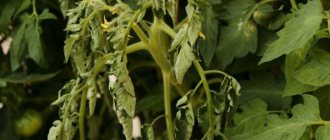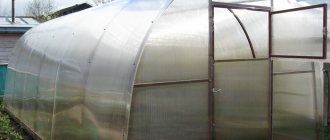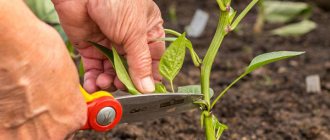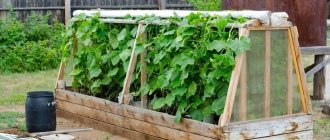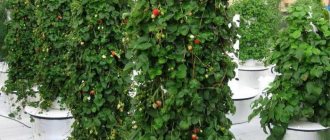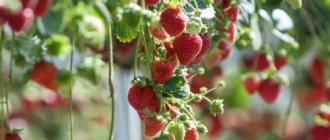Strawberries (although it would be more accurate to call them nutmeg strawberries) are a plant that requires warmth and moisture for development and fruiting. If there is a lack of moisture, it dries out quickly, and at low temperatures the roots can easily freeze - and while the problem of aridity is easy to solve, dealing with frost is more difficult. The peculiarity of strawberries is that they tolerate winter cold much easier than spring temperature changes. True, a plant can successfully survive the cold only if the winter is snowy (or not too cold - at −40, the berry will not grow without shelter). Otherwise, the ground freezes, and the roots of the plant freeze along with the ground, ensuring its rapid death.
Before answering the question of what frosts strawberries can withstand in the spring, you need to decide what specific period of spring we are talking about. Until it finally starts to get warmer and the snow completely melts, the berries, in fact, are not in danger.
Strawberry
In the spring, after the snow cover has melted and the berries have finally “awakened,” strawberries can withstand frosts down to −10 degrees, and only if the plant is strong and well-developed. Otherwise, it can easily die - both as a whole, starting from the roots, and just the flowers.
In general, if in winter or late autumn a berry normally tolerates frost under a layer of snow, then strawberries and frosts in spring (or early summer) are incompatible.
Is there any point in covering strawberries for the winter?! Useful tips for preserving berries
Gardeners have divided opinions about covering berries for the winter: some believe that there is no need to cover the crop, while others, on the contrary, believe that it is necessary to cover it. After all, juicy and tasty garden strawberries (also called strawberries) are the most common berry crop. It's hard to imagine a blooming garden without strawberries! Let's try to figure it out.
Strawberry
able to withstand subzero temperatures in winter, but in the presence of snow. A layer of snow, which is 12-15 cm thick, protects the crop from low temperatures (this is somewhere down to -25-30 ° C). If the temperature is below -12-16°C and there is no snow, then the plants freeze and may even die. Therefore, if the winter is not snowy, then the strawberries need to be covered.
Please note: if you choose, for example, straw as a covering material, there is a risk of mice appearing that will harm the crop. Therefore, it is worth taking care of getting rid of mice. The easiest way is to use an ultrasonic repeller - due to unpleasant sounds for them, they leave the area forever.
The question is quite simple, but important. subscriber
Alexander
helped me decide when it’s best to cover the berries . For which I want to thank him!
1. When the ground freezes 2 cm.
2. When the temperature drops steadily (after a week) to -5...-8 °C and before snow falls.
3. Before snowfall with stable sub-zero temperatures.
4. In the middle zone, it is advisable to cover strawberries at the end of October, and in the northern regions in the middle. In the south the event takes place at the end of November.
How to cover strawberries: choice of material
Some people cover strawberries with oilcloth, but I am against such a covering: the berries can rot and steam. I cover it with something breathable, most often spruce branches or covering material Agrospan 90
. In general, there are many options: it can be not only spruce branches, but also fallen leaves and reeds. Before sheltering, before stable frost sets in, I always water the strawberries generously.
Please note: another mistake that gardeners make is covering strawberries with sawdust. They will pick up moisture and when the sun warms up in the spring, they will ripen, and besides, pulling out small sawdust from ripe berries is not an easy task.
Spruce spruce branches
: It is advisable to collect covering material from broken branches. Don't just cut off paws from healthy trees. It’s good if there is a forest nearby - you can find more than a dozen spruce paws, and this amount will be enough for two beds. The main thing is that the material is completely distributed throughout the entire bed and covers the leaves well.
Leaves
: long-decomposing foliage is suitable for shelter. For example, foliage of walnut, poplar, horse chestnut, oak, American maple. This cover is just perfect! In addition, the foliage is quite heavy, and if it freezes or gets wet, then if anything can blow it away, it will only be a strong gust of wind.
source
Shelter technique
By the onset of winter, strawberries should grow healthy leaves, which will provide excellent protection for the buds from frost. In autumn, you should follow the rules of agricultural technology, applying fertilizers and removing pests. At the end of summer, it is recommended to loosen the soil around the bushes. Strawberries should not be transplanted too late. It is also better to remove weeds in the spring. Snow can serve as the best thermal insulation for a plant, as it prevents the soil from freezing.
A layer of mulch consisting of humus, reeds, peat, pine and spruce needles, and reeds can prevent cracking of the soil. Its reserves should be stored in bags or simply poured out near the strawberry beds. Mulch should be used in an amount of approximately one bag per 24 - 26 plant bushes. Dry mulch, taken in an armful, needs to be covered on all sides with adult strawberry bushes, the layer should be about 10 - 15 cm.
After the first light frosts, the strawberries need to be covered
Here it is important to take into account factors such as the geographical location of the site and its microclimate. To protect your garden strawberry bushes, cover them with plenty of straw.
Just make sure that there are no seeds in the straw that can attract rodents, or sawdust.
In order to properly cover the plant, a material such as agrofibre is used. The thickness of the strawberry cover layer should be about 6 - 8 cm. If a little snow falls in winter, the bushes not covered with it can die due to the onset of sharp frosts. To delay the melting of snow in your garden area, it is recommended to shade it with large boxes or other materials that are on hand. When it gets warm, the bushes of the plant should be freed from covering material so that they can have an area for normal growth and development.
Agrofibre can also help combat the negative impact of spring frosts on strawberries. They need to cover the plant at night and remove the material in the morning to allow the bees to pollinate the plant. Experts advise, whenever possible, to grow those varieties of strawberries that are most suitable for your region. If there is a sufficiently large layer of snow, they can overwinter even without special shelter.
How to prepare strawberries for winter
Before sending your favorite berries for the winter, you should consider 2 important points:
1. The roots of garden strawberries are located in the zone 6–8 cm in the ground
- Consequently, in snowless winters with severe frosts, the plantation may die completely.
- Even if a thin layer of snow falls, severe frost will destroy the strawberry root system.
The roots of hardened strawberries (if the temperature drops gradually in autumn) can withstand up to -8 °C, the above-ground part - up to -18 °C. Young plants are more winter-hardy than old ones.
2. The above-ground part of strawberries is more durable and resistant to the vagaries of weather and frost
- However, if there is no snow and the temperature drops below -10 °C, then the risk of plant death is high.
- Temperature drops during northern winds are especially dangerous.
- Therefore, on the north side it is advisable to install at least simple barriers - for example, pieces of cardboard or slate.
When to cover
The timing of covering garden strawberries is very important. There is no need to rush, but there is no need to delay it.
- If you cover garden strawberries too early, warming may occur, it will rain and the plants will rot.
- If you delay with the shelter, the strawberries may simply freeze.
— If, when the above-ground part freezes, it still has a chance to recover next year, then when the roots freeze, the plants will die completely.
Covering garden strawberries should begin when a series of small frosts have passed - the weather should remain at 0. -2 ° C for a week.
If the soil froze by 2 cm during this period,
then it’s time to start covering
. You need to cover the plants when a stable minus has established both day and night (if it’s still warm during the day, damping off may occur due to early covering).
Therefore, the optimal time for shelter is November
Photo: start covering strawberries in November
What to cover
You can cover strawberries with almost anything: plant and synthetic materials. The only things you should not use are garden waste and weeds.
1. Straw is a very good option.
- If you decide to make straw shelters, place rodent poison next to the beds.
- And to prevent the straw from scattering around the area, it needs to be weighed down with something - for example, spruce branches or branches.
These materials hold snow well on the site and can be easily and quickly removed and burned in the spring. Moreover, such material costs nothing.
2. Gardeners often use non-woven covering material
- or they make small “huts”, on which they throw exclusively black non-woven material,
- or drive pegs around the perimeter of the bed, leaving them protruding 30–40 cm from the soil. Covering material is already laid on them, securing the edges with bricks or stones.
Do not lay covering material directly on strawberries
without additional support.
In a snowless winter, the soil with it will freeze even faster.
The option with frames + non-fabric is very good. However, if at least a 30-centimeter layer of snow accumulates on the beds every winter, the plants do not need to be covered additionally.
Photo: mulching strawberries with straw for the winter
Why cover strawberries and is it possible not to do it?
Young strawberries planted this season must be covered for the winter.
Strawberries themselves are quite resistant to the effects of cold. If the temperature in the region does not drop below -20 °C and there is a lot of snow, it is not necessary to cover the plantings for the winter. But a lot depends on the variety and growing conditions. Some varieties of strawberries can easily withstand the harsh winters of the Urals and Siberia, while others need to be protected from the cold even in the South.
First of all, young strawberries planted recently - in August or September - need shelter. The rosettes do not have time to grow strong roots by winter and may freeze out.
It is important to take into account the climatic conditions of the region. If the area is characterized by frequent thaws followed by frosts, it is imperative to protect the plantings. The plant may mistake the warming for the beginning of spring and begin the growing season, and die if there is an unexpected cold snap.
It is recommended to cover strawberries for the winter in regions with strong winds and poor snow cover. Under such conditions, plantings are not protected from frost, the soil and root system are dried out. Even in places where winter temperatures are acceptable for crop growth, strong air currents can destroy plants.
The plant must be covered for the winter in areas with harsh winters - in the Urals, Siberia and Transbaikalia. If the temperature in the winter months drops to -45...-50 °C, even high snow cover will not save you.
What to do with strawberries after winter
Strawberries without shelter or without snow can withstand temperatures down to -18...-23 °C (imported new products - up to -15 °C), roots die at -8 °C, flowers - at -1 °C. Therefore, immediately after the snow melts, the plantation is insulated with agrofibre; if there is a threat of severe frosts, use double shelter.
Insulate
- Immediately after the snow melts and later - if there is a threat of frost in the phases of active leaf growth, budding and flowering - the plantation is insulated with agrofibre;
- If there is a threat of severe frosts - up to -8 ° C - double shelter (agrofibre + film).
- If this is not possible, water heavily before and after frost.
Clear
- Brown, dry leaves and bushes are removed from the plantation.
- Green leaves are cleaned of dirt (refreshing watering is carried out) if there is no rain.
In spring, the roots should not be damaged. Therefore, the rows are not dug up, but loosened with weeding.
Handle
- To prevent diseases, the leaves are sprayed with a 3% urea solution, and the soil under the bushes is dusted with ash (300 g/m²).
- To protect against rot, the ovary is sprayed 1–2 times or watered with biofungicides from a watering can ( Sporobacterin
,
Trichocin
,
Baktofit
,
Glyokladin
). - To combat the weevil, the bushes are sprayed with Fitoverm
during the budding phase and damaged buds are collected.
Fertilize
Strawberries do not tolerate an excess of fertilizers.
- Plantations are fed 2–3 years of life - at the beginning of leaf regrowth with complex fertilizers with a predominance of nitrogen, urea or ammonium nitrate (10–15 g/m²).
- Spraying microelements with humates during the budding phase helps increase yields by 10–20%.
- Watering with humates is useful during the growth phase of the ovary.
Water
Watering simultaneously with fertilizing promotes the rapid growth of strong leaves, which increases resistance to strawberry mites. Water the strawberries twice during the budding phase and during ovary growth, preferably by overlapping, soaking a 30 cm layer of soil.
Frequent and shallow watering contributes to the development of diseases.
Mulch
Mulch strawberries immediately after warming the soil with organic materials (peat, compost, straw) or agrofibre. Composts and peat serve as food, straw and agrofibre protect the berries from rot.
The new plant is mulched immediately after planting (to prevent drying out, protect against weeds, and improve rooting).
Call our free editorial hotline
Anna Solovyova, Novosibirsk region; Nikolay Khromov, Tambov region.
Read even more articles on our website “Antonov Sad.ru”
source
Honeysuckle: main characteristics of the plant
Honeysuckle is less popular to grow than other garden crops. However, many people love this plant for its beautiful appearance and tasty fruits.
Did you know? The fruits of some varieties of honeysuckle, for example, “wolfberry”, are poisonous to humans.
There are edible and inedible forms. The first type bears fruit with sweet berries and has the appearance of a bush with straight shoots and a crown. Inedible varieties are grown for garden decoration. They are shaped like climbing vines, making them great for creating hedges.
Origin
There are 200 different species and varieties of honeysuckle, so it is difficult to name the birthplace of the culture. Scientists suggest that the ancient wild forms of the plant come from Southeast Asia - the largest number of varieties is concentrated here. Honeysuckle is also distributed throughout the Northern Hemisphere, except the Far North.
Frost resistance of a plant: what frosts are critical for a plant
Due to their northern habitat, most honeysuckle species are considered winter-hardy. However, the reactions of buds, roots, young and woody shoots to frost are different.
Also find out whether currants are afraid of spring frosts.
Average data on the temperature critical for a crop are as follows:
| Roots | up to -40°С |
| Flower buds | up to -40°С |
| Growth buds | up to -50°С |
| Woody shoots | up to -50°С |
| Young ovaries | up to -8°С |
What frosts can strawberries withstand in spring?
Is it possible to water plants before frost?
Not only is it possible, but it is also necessary. If frosts are expected to be at least -5 degrees, and the weather is calm, then sprinkling is used.
To do this, water is sprayed onto the plants and soil using a sprayer or drip irrigation systems.
Water has a high specific heat capacity; when it gets into the soil, it gives off heat, thereby warming the soil and preventing the roots from freezing.
In addition, when water evaporates, water vapor will condense around the above-ground parts of the plants, which will slightly increase the air temperature and also prevent colder air masses from descending to the ground and roots.
Will there be frosts in June?
In principle, in May and June there are often so-called return frosts - a nighttime drop in air temperature to zero or below. This phenomenon is dangerous for heat-loving plants. Now it is difficult to give an accurate forecast of what the weather will be like in June, but some forecasters are already saying that the temperature on June nights can drop to +11 degrees.
You should expect night frosts if, after a hot day, the temperature suddenly begins to drop sharply. In this case, experienced gardeners use covering material to protect the crops from freezing.
How to feed strawberries at the beginning of flowering?
Alcohol tincture of iodine is also used to ensure that strawberries grow well after wintering. The appropriate proportion is: 10 drops/10 liters. In total, you need to perform 3 waterings (the period between procedures will be 7 days). It happens like this: we cut out the dead wood, water it and only then feed it.
Before flowering, some agronomists also advise using the following fertilizer: ash (take a glass), boric acid (teaspoon) and 30 drops of iodine diluted in a 10-liter bucket. Let it sit for several hours and pour up to half a liter under the bushes for each
How to save seedlings in a greenhouse from frost?
We do not tie up the tomatoes for as long as possible. Install arcs inside the greenhouse, cover the seedlings with non-woven material and cover with plastic film on top, resulting in a triple cover. I bring as many containers of water into the greenhouse as possible. When a sharp drop in temperature is expected, as happens in Siberia down to 10 below zero, we light candles at night. Even if the tomatoes freeze slightly, it’s only the tops. If we wait until the frosts end, we will only receive tomatoes at the end of August. You need to be able to deal with low temperatures and plant seedlings at the optimal time.
Sweet pea, or sweet pea
Sweet pea is a true garden orchid with a fragrant scent! The plant is as unpretentious as it is delicate in appearance, although it can withstand frosts down to –5°C. An annual crop will give a head start to a perennial one in the rich palette of shades and colors inherent in flowers - their wavy petals are white, pink, bright red, dark cherry and even blue. There are 1000 different varieties of sweet peas! Agree, such a colorful “set” alone can make up an entire flowerbed.
The plant will “like” open sunny areas where there is no strong wind. The soil is light, loose, fertile and breathable, with a neutral pH. It is better to prepare the soil in advance (at least two weeks in advance) by adding compost and mineral components - potassium and phosphorus.
Before sowing, it is better to soak the seeds (except for varieties with light flowers) in hot water for 2 hours - this will speed up germination. They are embedded in the soil in a nesting manner (2-4 pieces per hole 2-3 cm deep). In two weeks, the seedlings will germinate, and you will have to wait another 2 months for flowering, but it will not upset you, especially if you “spur it” with liquid fertilizer with minerals once every two weeks. If you pick off inflorescences that have bloomed, colorful bright flowers will bloom until mid-autumn. Do not forget also about regular and sufficient watering, loosening the soil and all standard procedures to which plants respond with harmonious growth and development.
Make sure that the plant has a vertical support along which it will climb - this could be a fence, a low hedge, or a wattle fence. Alternatively, you can stretch twine in the form of a net between two supports. Moreover, it is better to do the garter early, because... Pea stems are fragile and can easily break.
Sweet peas are suitable for landscaping gazebos, decorating arches, trellises, and creating landscape compositions in a rustic style.
Features of culture
Strawberries are plants that go under the snow with a full set of green leaves.
This fact confuses novice gardeners, but for a perennial plant the lack of complete shedding of greenery is the norm. Strawberries gradually renew their leaves throughout the warm season. This can be easily seen - on the bush there are always large adult specimens and very young bright green ones that are just blooming. Withered leaves are also adjacent to them. The mentioned distinctive feature of strawberries dictates the characteristics of caring for bushes. For example, it is important to perform anti-aging pruning on time, otherwise problems may arise with the health of the plants. Strawberries are trimmed immediately after fruiting. The leaves are cut off completely at a short distance from ground level. Since the last berries are harvested in mid-summer, the bushes have plenty of time to grow new greenery. Lush crowns are needed in order to survive the winter easily and without loss. The leaves actively accumulate useful substances, and the strawberry receives everything it needs to protect itself in the cold. The more lush and spreading they grow, the better shelter they become for horns and delicate flower buds. Leaves retain the snow and prevent the winds from blowing it away. A white fur coat is the best shelter from the frost. All of the above applies to ordinary varieties that bear fruit once a year. If we are talking about remontant strawberries, then complete pruning is prohibited. Old and dried leaves are removed as needed throughout the warm season.
Unfortunately, nature is not always able to cope with all problems. There are winters when even cold-adapted strawberries need some support from gardeners. Additional protection is a solution to the problem and a guarantee that the bushes will greet you with bright greenery in the spring and will soon delight you with a new harvest.

